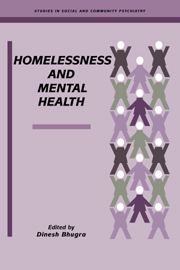Book contents
- Frontmatter
- Contents
- List of contributors
- Preface
- Part I INTRODCTION AND SPECIAL GROUPS
- 1 Introduction
- 2 Homelessness and mental illness: a brief history
- 3 Models of homelessness
- 4 Young homeless and homeless families: a review
- 5 Homeless women
- 6 Homelessness and criminality
- Part II SERVICES
- Part III INTERNATIONAL PERSPECTIVE
- Part IV POLICY AND EVALUATION
- Index
4 - Young homeless and homeless families: a review
from Part I - INTRODCTION AND SPECIAL GROUPS
Published online by Cambridge University Press: 15 October 2009
- Frontmatter
- Contents
- List of contributors
- Preface
- Part I INTRODCTION AND SPECIAL GROUPS
- 1 Introduction
- 2 Homelessness and mental illness: a brief history
- 3 Models of homelessness
- 4 Young homeless and homeless families: a review
- 5 Homeless women
- 6 Homelessness and criminality
- Part II SERVICES
- Part III INTERNATIONAL PERSPECTIVE
- Part IV POLICY AND EVALUATION
- Index
Summary
Introduction
The most alarming increase in the homeless population over the last 20 years has been the dramatic rise in the number of homeless families with children. The homeless youth have appeared in increasing numbers on our streets. In England, Shelter (a charity for the homeless) estimated that 58 000 people were either sleeping rough or were unauthorized tenants or squatters. Up to another 137 000 single people were estimated to be living in hostels and lodgings in addition to 317 000 insecure private tenants and 1.2 million ‘hidden’ homeless (Burrows & Walentowicz, 1992). In the USA in 1986 it was reported, following a survey of 25 cities, that 80% of the sample had reported an increase in the number of homeless families with children (US Conference of Mayors, 1986). A year later on average the numbers had gone up by another one third (US Conference of Mayors, 1987).Various changes in housing policies and a reduction in available housing stock available at affordable rents along with low cost new building are among some of the reasons for this increase (see Chapter 3). For homeless families stresses and coping strategies are different from those experienced by the single homeless. In homeless families in addition to individual stress, there is also the impact on the family unit along with all of the interactions that happen between the unit members. Within that unit, family homelessness can affect not only emotional growth but behavioural and nutritional status of the children.
The stereotypes of homeless youth running away towards the bright lights does not hold up to close scrutiny. There is no typical homeless family or runaway or homeless youth.
- Type
- Chapter
- Information
- Homelessness and Mental Health , pp. 41 - 58Publisher: Cambridge University PressPrint publication year: 1996
- 2
- Cited by

